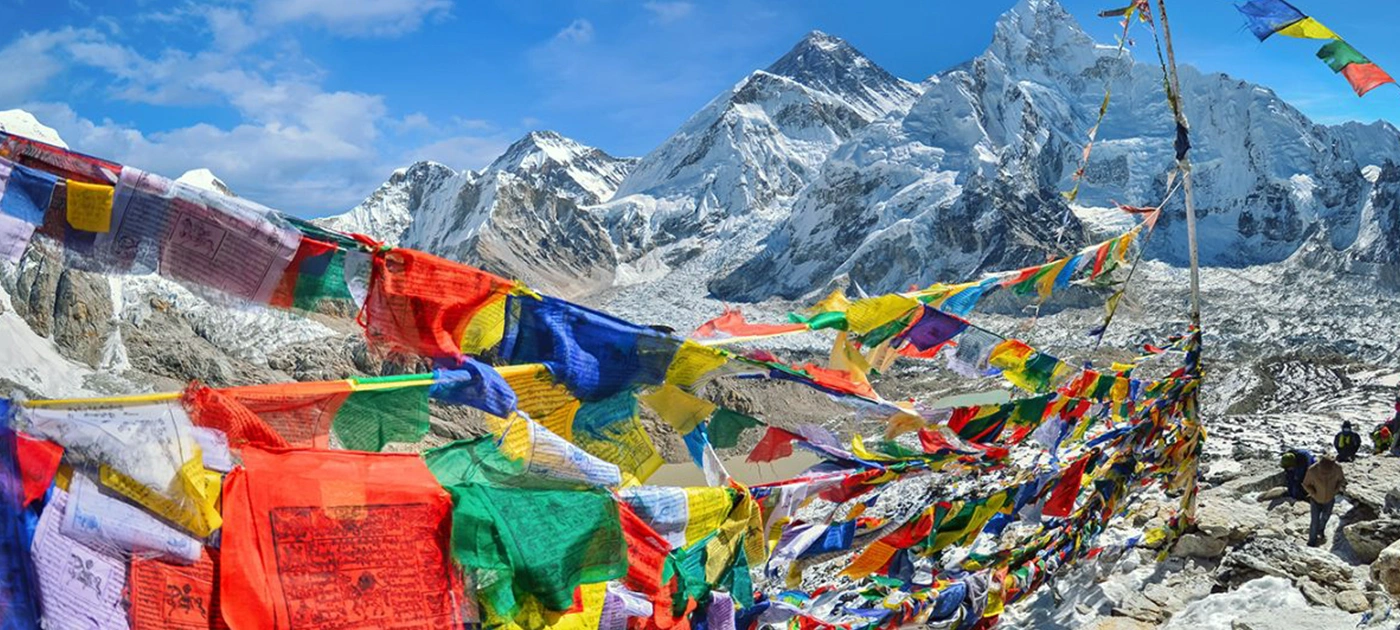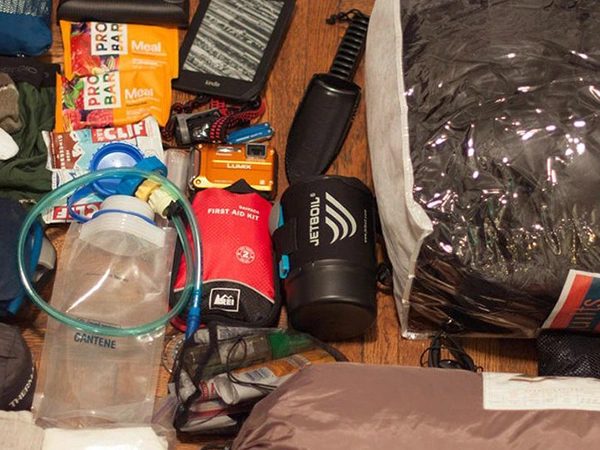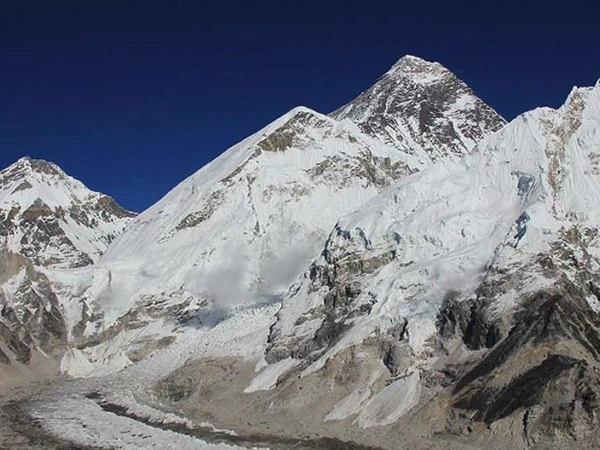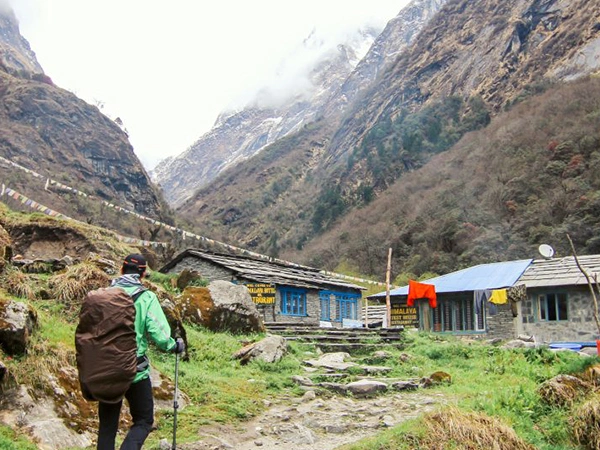Everest Base Camp trek in March is an experience that you will have once in a lifetime. March is one of the peak trekking months in the high Himalayas of Nepal when you can witness the towering snow laden mountains in their full glory. Moreover, during this enchanting springtime, you get to enjoy the wholesome trekking without the large crowds that begin to arrive in the later months.
The weather in March is usually stable with cloudless skies affording breathtaking views of the snow capped peaks. This month usually has very little to no rainfall. Hence, it is pretty dry with small precipitation, moderate humidity, high visibility and crispy and fresh air. Likewise, the temperatures are not too high or too low. The moderate heat of the gentle sunshine makes trekking easier and more enjoyable. The cooler climate reduces the amount of sweat and physical stress, thus helping you to maintain energy throughout the day.
Besides magnificent mountain views, March treats you with the beauty of spring blooms. Rhododendrons and other wildflowers start to bloom with the onset of spring in March which adds striking bursts of color amidst green hills and forests. The Everest Base Camp trek in March is, hence, a captivating time that rewards with first glimpses of the beauty of the floral blooms in the Everest region.
Additionally, the Everest Base Camp trek in March is one of the good times to feel the rich Sherpa culture more intimately. Unlike the busy trekking months, the serene trails sweep you off your feet, taking you to ancient monasteries, traditional locals and a true picture of those age-old practices in this region.
The quieter trails, mild weather, cultural immersion and breathtaking scenery combine to make the trek to Everest Base Camp in March unique and rewarding.
Major Appeals of Everest Base Camp Trek in March
- The Everest Base Camp trek March weather is usually stable with clear skies and a dry ground which is best suited for trekking.
- The moderate temperatures during the daytime make it pleasant to trek as you would hardly get excessive sweating or discomfort from extreme heat or cold.
- The precipitation rate is low and the air is clear. This provides crystal clear visibility to all fantastic Khumbu Himalayas.
- Rhododendrons and magnolias start to bloom, adding colors to the landscape, which looks really stunning with green hills, blue sky and snow-white mountains in contrast.
- As the initial month of trekking, March offers a peaceful environment for this iconic mountain adventure. You can deeply connect with nature and enjoy the solitude of the Himalayas during this time.
- Reflective water bodies filled with fresh snowmelt water. The enthralling mirroring of the Himalayan ranges in the shimmering surfaces of lakes and streams is visually stunning.
- Unobstructed vistas of the marvelous mountainous scenery due to the atmosphere free of haze or clouds.
- Rich cultural exposure to the local Sherpa people, monasteries and villagers away from the crowd. Ideal time for photography with striking landscapes and vivid conditions.
- Vibrant atmosphere in the trails and teahouses towards the end of the month as worldwide adventures start to flock into the region. This provides you with an opportunity for cross cultural exchange.
- High chances of spotting the wild creatures in the region emerging from hibernation to forage and breed. You can also see different migratory birds returning from their winter habitats.
- Blooming hills and forests filled with the sweet aroma of fresh vegetation and melodious chirps of songbirds.
- Passing through the abundant biodiversity of the Sagarmatha National Park which is full of life with the vibrant colors of spring blossoms, bird’s chirps and the activity of wildlife.
What Makes March the Best Time for the Everest Base Camp Trek?
Delightful Weather
Everest Base Camp Weather in March is delightful. The month brings dry, mild and cool climate that remains pretty stable. The sunshine is bright and gentle and the daylights start to increase. This makes the March days to be long, warm and vivid. The sky remains cloudless and deep blue crystal clear and the atmosphere is free of hazes or dust. The air is soothing and fresh to breathe in.
On the other side, the upgraded visibility enriches the trek, treating you to the grand views of high Himalayan peaks. Likewise, lessened rainfall and pleasant weather patterns reduce the chances of disruptions. Furthermore, the dry atmosphere also means the trails are less muddy, thus making the trekking experience comfortable and enjoyable.
Mild Temperature
Everest Base Camp temperature in March is moderate. It is the best time to go for the EBC trek if you want to skip the extreme cold of winter or the heat of summer. In the lower trekking regions, the daytime temperatures usually range from 10 to 15 degrees Celcius, thus providing comfortable conditions to trek.
Nights are a bit cool. Temperatures sometimes fall to as low as 0 degrees Celsius. However, this is manageable for those properly dressed and equipped for trekking. Since the temperature at Everest Base Camp in March is mild, it is a great time to visit the Everest region without any discomfort.
Unhidden Mountain Vistas
The most appealing side of the Everest Base Camp trek in March is the unobstructed mountain views afforded by the clear skies and dry conditions of the month. Since the weather is usually stable and clean, no clouds hinder the magnificent vistas of the towering peaks of the Himalayas.
This is one of the best times to trek with the stunning backdrop of lofty Everest, Lhotse, Makalu and Ama Dablam, among others, along with lush valleys and rugged high altitude terrain throughout the journey.
Furthermore, the crisp, fresh air heightens the visibility with the snowy peaks and surrounding valleys looking all the more vivid and striking. Be it during the walkthrough of the Sagarmatha National Park or reaching higher viewpoints of Kala Patthar, the clarity of the views in March is exceptional.
Possibility of Wildlife Encounters
March marks the beginning of spring when the lower regions’ forests and vegetation start to regenerate and gives opportunities to view many birds and wildlife. As you trek through the Sagarmatha National Park, the precious mountain creatures adapted to the harsh alpine environment will begin to emerge.
So, there is a better chance of seeing Himalayan birds and animals, such as Himalayan Tahr, Pheasants, Tibetan Snowcock, Snow Leopard, Red Panda, Musk Deer, Wild Yak etc in their natural habitat. This is mainly favored due to the mild climatic conditions of March when wildlife come out of their winter sleep and become active in search of food and for breeding.
Colorful Landscapes
The trek to the Everest Base Camp in March is a charismatic and magical experience. In the lower and mid altitudes, the arrival of spring heralds a mesmerizing landscape. Colorful rhododendron forests burst into bloom with trails painting red, pink and purple hues.
Likewise, magnolias and other wildflowers start to dot the meadows and valleys. This contrast of blooming flowers in diverse colors to the rugged mountainous terrains and snow coated mountains framed by the azure sky creates a spellbinding visual spectacle.
Difficulties of Everest Base Camp Trek in March
Lingering Cold
The transforming weather in March from winter to spring lets you experience the lingering winter chill during the early days. The temperature at higher altitudes, especially in the mornings and evenings, is very chilling. This makes it necessary to pack for sub-zero temperatures at alpine altitudes, such as Dingboche, Gorak Shep and Everest Base Camp.
Unsettled Conditions
Everest Base Camp March weather is usually more stable than during the winter months. However, the conditions are still not well settled. There is a chance of snow in alpine areas with chilly air and quick changes in weather. The trails may be covered in snow or slippery in some areas due to the snow melting. Besides that, ice patches on the track may send you sliding down with potential injury from sprained ankles and broken bones to other more serious accidents.
You should pack carefully, as the favorable spring conditions have not yet fully settled in. In comfort, safety and good navigation, warm layers are required along with reliable trekking poles and boots that have good traction.
Less Daylight
Daylight hours will gradually increase with the initiation of March. However, the days are still relatively short compared to the other spring months of April and May. This means the trekking day may end earlier and you will have to plan for less time on the trail.
On top of that, as the darkness closes in, the temperature falls rapidly and it gets very cold. Therefore, the early start of the trek and finishing it by evening helps you to avoid getting caught in the dark and cold conditions.
Risk of Dehydration
Although the temperatures are generally milder in March, increasing cold with the rise in altitude may trick you into not hydrating properly. You may not get the sensation of thirst in cold conditions which can easily lead to dehydration. Therefore, it is very important to keep drinking water throughout the trek even when you do not want to. This is something you should be careful about to avoid complications from altitude sickness.
Carrying a hydration system or water bottles is important to ensure you drink enough (at least 4 liters per day) on the trek.
Trail Traffic in March During EBC Trek
March is one of the spring months when many trekkers prefer the trek to Everest Base Camp for more favorable conditions. Still, the traffic along the trail remains usually moderate. You may get to see some fellow trekkers but not too many and that is an assurance of silent trails and quiet surroundings.
Being one of the early months of the trekking season, March offers ideal conditions for those seeking a quieter journey through the Khumbu region. It is not as crowded as it gets in the April and May months of spring. This, in turn, makes March a very good time for trekkers who are in search of a serene trekking experience.
March lets you fully appreciate the magnificent Himalayan surroundings of the iconic Everest region. It provides space to take in the awesome views of the gratifying mountains without large groups of people. Moreover, quieter trails offer a far more personal experience with the culture of the local Sherpas. This is also because you can visit monasteries, interact with villagers and explore all the rich traditions of the region without any distractions or competition.
Overall, March offers a great balance of good weather, manageable crowds and the beauty of the trek without the congestion of the high season.
Everest Base Camp Trek in March – Trail Conditions
Generally, the conditions of the trails in March along the Everest Base Camp trek are usually negotiable for most trekkers. However, it is sometimes a bit obstructed due to cold temperatures and occasional snowfall.
The lower parts of the trek, including Lukla, Phakding and Namche Bazaar, usually have clear and well maintained paths, making the trek relatively easy. As you go upward, the paths become rough, steep and sometimes covered by snow or ice. This is particularly probable in those parts that may face away from the morning sun or might be in the shade.
March is the commencement of the spring season, which means snow melt is expected and part of the trails are likely to be muddy and slippery. While the paths can normally be managed, you should still be careful with the slippery ground of melting snow or icy patches.
Overall, March offers favorable trail conditions for trekking with the right preparation and equipment.
Accommodation and Food Options During the Everest Base Camp Trek in March
During the Everest Base Camp trek in March, you will find a range of accommodation facilities along the route. The number of trekkers in March is comparatively less than in the later spring months. So, finding space is usually not that difficult in these tea houses. However, toward the middle of the month, the number of trekkers starts mounting, especially at major stopping points like Namche Bazaar, Tengboche and Lobuche.
On the other hand, the teahouses that lie remotely along the trail sometimes have minimal food and sleeping options or they may not cater to the needs of the large trekker’s group. Likewise, there may not be as many trekkers to fill the teahouse space during this time, making them not so functioning. So, confirming the availability of accommodations and booking them in advance is often necessary.
In the teahouses, you will get a variety of meals ranging from local delicacies such as dal bhat and momo to international cuisines like pasta, pizza, sandwiches and pancakes. These meals are mainly prepared from locally grown crops and vegetables, which include paddy, buckwheat, potatoes, cabbage, carrots and leafy vegetables. While the meals are healthy and nutritious, they will be very limited towards the higher ascents.
Nonetheless, keep in mind that food may become more expensive as you climb more due to the difficulty of supplying goods and amenities to these regions. Because fresh produce is rarely available at alpine elevations, you often have to carry snacks or supplements if you want more variety in your diet.
Guide and Porter Availability in March
The guiding and portering services for the Everest Base Camp trek are pretty adequate in March since it is when the adventures in the Himalayas commence. March is not as busy as April or May when more trekkers visit. So, you can expect guiding and carrying services to be readily available.
We recommend you take guided treks through reputable trekking companies where logistics, navigation and safety are assured along with insights into the historical and cultural aspects of the region.
You are more likely to have a personal experience with your guide and porter in March as the trails are quieter compared to later months. However, as the month goes on, guides and porters may become busier with more trekkers arriving in the region. In addition, the demand for their services increases and so does the price.
Therefore it is essential to make a prior booking through a recognized trekking agency to ensure availability in advance and avoid last minute hassles.
Everest Base Camp Trek in March – Cultural Encounters
March is a very good time for cultural excursions in the Everest region. The trek to Everest Base Camp in March provides you with the unique opportunity to be part of the rich cultural heritage of the Sherpa people. You will be able to visit monasteries and discuss the traditions and customs the Sherpas have with them.
The fewer tourists in March will allow you chances to get closer to the local people and experience their culture and daily lives in a more personal way. It is the ideal time for adventurers to enjoy these cultural encounters without the hustle and bustle.
March marks the arrival of spring and it is during this season that one of the most important Buddhist festivals of Buddha Jayanti falls. Even though the festival takes place in the later spring months, the pre-festive atmosphere in the villages along the trail immerses you in the vibrant cultural energy of the region.
Besides, Losar, the Tibetan New Year, is the major happening in the local Buddhist community, often falling at the start of March making the region more lively.
You May Also Like:
- Everest Base Camp Luxury Trek
- Everest Base Camp Trek in September
- Best Time to Go trekking in Nepal
Photography Opportunities During EBC Trek in March
The Everest Base Camp trek in March is the best treat for photography enthusiasts. The snowclad peaks of Everest, Lhotse, Makalu, Ama Dablam and many others provide a striking backdrop to the trekking journey. These majestic Himalayas stand against the clear, blue skies and are seen with utmost clarity favored by the dry and stable climate.
The sharp visibility in the environment allows photographers to click panoramic shots of towering Himalayas without haze or cloud cover. Likewise, the soft morning light falling on everything from high-altitude terrain to deep valleys and glaciers presents a dramatic scene for photography. March is the time when photographers can shoot the rugged beauty of mountains and mountainous landscapes in perfect wide angle shots.
March brings the Everest region a color splash with rhododendrons and wildflowers blooming along the trail. The woods are painted with red, pink, purple and yellow hues, thus creating a contrasting beauty against the snow dusted landscape. Moreover, the start of the spring season brings in more active wildlife, thus offering more photo opportunities.
On the other hand, the traditional Sherpa villages, Buddhist monasteries and prayer flags enrich your photography portfolio with unique shots of the local way of life framed in stunning natural beauty. In a nutshell, from dramatic mountain views over vivid flora to cultural landmarks, March is an excellent time for photographers to capture the diverse beauty of the Everest region.
Packing Essentials for the March Trek of EBC
Trekking Gear
- A roomy backpack
- A light and small daypack
- Waterproof covers for your backpack and daypack
- UV filtering sunglasses to protect the eyes from snow reflection and high altitude sun
- Flashlight or torch with extra battery pairs
- Trekking poles
Sleeping Gear
- Ear plugs
- Sleeping bag rated for temperatures as low as -10 degrees Celcius
- Sleeping bag liner for an extra layer of warmth
- Travel pillow
- Sleeping pad
- Eye masks
Clothes and Footwear
- Quick drying thermal tops and bottoms to keep you warm and dry
- Lightweight and breathable trekking pants with zip off options for warmer daytime temperatures. Fleece jacket or down sweater for extra warmth
- Waterproof jacket and pants for protection against rain
- Windbreakers
- A warm and compressible down jacket for chilly mornings and evenings
- Comfortable long and short sleeved trekking shirts
- Two pairs of warm insulated gloves for cold mornings and evenings
- A pair of lightweight liner gloves
- Woolen hat or beanie
- A sun hat
- A few pairs of moisture wicking and warm trekking socks
- Buff or neck gaiter
- A pair of thermals to wear on colder nights.
- Sturdy, waterproof and broken in trekking boots
- Sandals
- Flip flops
- Light sports shoes for short day walks
- Woolen slippers
- Gaiters for extra protection against dirt and snow
Personal Items
- Thermal water bottles
- Water purification tablets or a filter
- Sunscreen with high-factor protection against the intensive sun at the height
- Lip balm with SPF to prevent lips from chapping in cold and wind
- Toothbrush, toothpaste, wet wipes, hand sanitizer
- Toilet paper
- Soap, shampoo and conditioners
- Small microfiber bath towel
- Deodorants and perfumes
- Moisturizers
- Ear buds and nail clippers
- Shaving cream and razor
- Compact mirror
- Hair ties and clips
- Menstrual hygiene items like sanitary pads, tampons
- Hair comb
Health and First Aid
- Painkillers
- Antidiarrheals
- Blister plasters
- Band-aids or bandages
- Diamox (anti altitude sickness medication)
- Insect repellent sprays to apply gainst mosquitoes and bugs in lower regions
- Instant cold packs
- Antiseptic cream
- Antibiotic ointment
- Cough syrup
- Nasal decongestants
- Paracetamols
- Gauze pads
- Cotton swabs
- Emergency blanket
- Hand warmers
- Heat pads
- Thermometer
- Tweezers
- Small scissors
- Sterilize gloves
- Submit Your Inquiry
Tech and Documentation
- Camera with extra batteries
- Tripod stand
- Smartphone
- Binoculars
- Chargers
- Adapters
- Power bank
- Travel Insurance
- Trekking Permits
- Visa
- International flight tickets
- Passport
- PP size photos
- Digital copies and photocopies of important documents
- Cash in Nepali Rupee
- Credit cards
Miscellaneous
- Energy bars
- Trail mix
- Electrolyte tablets
- Trash bags
- Notebook and pen
- Play cards
- Portable speakers
- Small locks





![Best Time to Do the Tsum Valley Trek in Nepal [With Trekking Tips]](https://himalayasonfoot.com/uploads/blog/best-time-to-do-the-tsum-valley-trek-in-nepal.webp)
